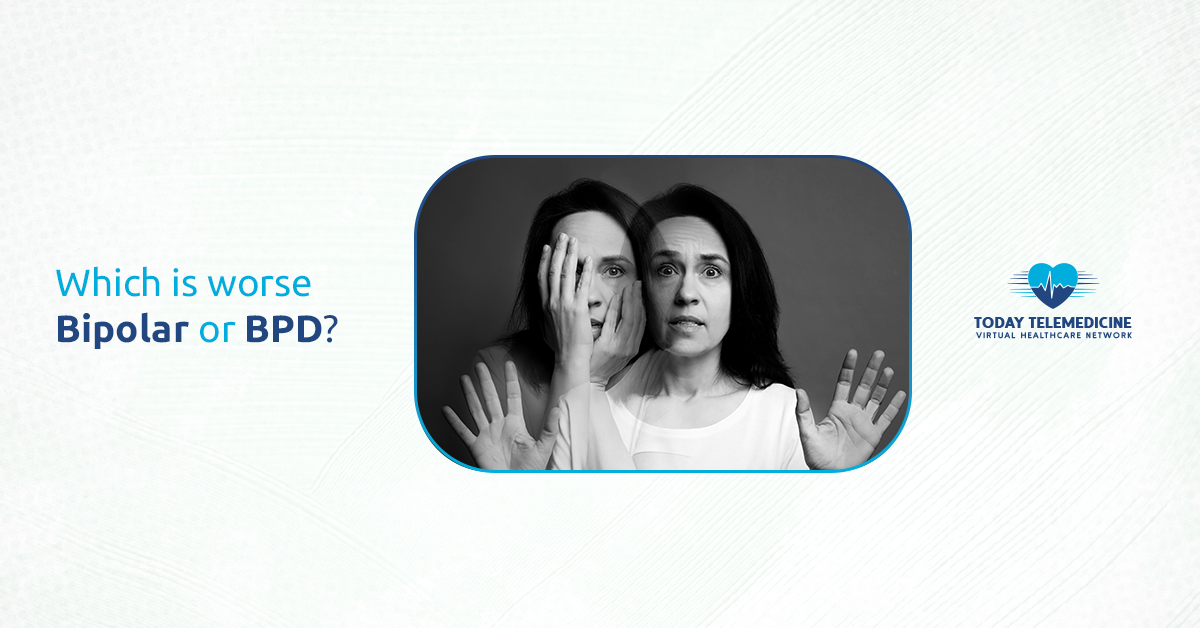Each mind’s struggle is unique. Mental health issues vary, from simple to complex. They resist easy categorization.
Bipolar disorder and borderline personality disorder (BPD) are commonly noted. Their overlapping symptoms can lead to questions.
Both disorders involve mood swings. However, they are distinct. Understanding each one better helps in management and support.
Struggling with mental health? Get help from a skilled psychiatrist. We’re prepared to assist. Today Telemedicine offers mental well-being care, accessible anytime, anywhere. Appointments can be made any day to suit your mental health requirements.
Below, we’ll explain the difference between Bipolar and BPD. Then, we’ll compare them and discuss their impacts, “Which is worse Bipolar or BPD?” As well, we’ll check out borderline bipolar symptoms, and solutions.
What Is Bipolar Disorder?
Bipolar disorder is marked by mood swings. It causes extreme highs and lows in patients. Manic episodes reach high peaks, while depressive ones hit deep troughs. These intense changes define this complex mental illness.
Mood swings can last a long time. Brief episodes may extend to weeks or even months. These intense emotional shifts come and go, lasting at different times.
There are three core forms of Bipolar Disorder:
- Bipolar I Disorder: It’s the worst kind. Those with Bipolar I go through strong manic times that persist for over a week or force hospital care. The down periods can also span several weeks.
- Bipolar II Disorder: In this, you’ll have tough depressive stretches, but the manic instances aren’t as harsh. We identify it as hypomania. It’s a milder type of mania.
- Cyclothymic Disorder: This indicates mellow indications of hypomania and dejection, enduring at least two years.
Bipolar Disorder sufferers might face mixed episodes. In these, they are in a state of both joy and sorrow together.
Causes and Risk Factors for Bipolar Disorder
Bipolar Disorder’s exact origin is unclear, but it probably entails numerous influences. It is a mix of genetics, environment, and brain factors.
If a family member has the disorder, another person’s chance of having it goes up. Big life stressors like trauma or great loss might also set off episodes.
What Is Borderline Personality Disorder?
Borderline personality disorder (BPD) is a concern with emotions. It’s marked by unsteady relationships, powerful feelings, and a bad self-view.
If you have BPD, you might quickly change moods, feel scared of being left alone, and struggle with your emotions. This condition often results in sudden actions and issues with controlling yourself.
Some common symptoms of borderline personality disorder include:
- Intense fear of abandonment
- Unstable relationships with others
- Impulsive behaviors
- Extreme mood swings
- Chronic feelings of emptiness or boredom
Factors and Risk Variables for Borderline Personality Disorder
People usually think BPD, like Bipolar Disorder, comes from a mix of factors. These include genes, biology, and environment.
A past filled with sad childhood experiences often shows up in those with BPD. Things like neglect or harsh treatment.
Also, unusual brain patterns might play a part. These could trouble a person’s ability to control emotions and impulses, leading to the disorder.
What’s the Difference between BPD and Bipolar?
The key difference between bipolar disorder and borderline personality disorder (BPD) is in the mood changes they cause.
Bipolar disorder mainly induces shifts from manic to depressive states, typically more enduring.
BPD, on the contrary, is marked by speedy mood changes, often over a day or just hours, usually linked to social scenarios or signals.
Bipolar vs BPD: Duration of Mood Swings
Bipolar Disorder
Euphoria rises, then falls to despair. Energy rises and then falls to exhaustion. These shifts can last from days to months. Brief calm periods occur between the extremes. Manic highs cycle into depressive lows, with stability in between.
Borderline Personality Disorder (BPD)
People with BPD often experience rapid mood swings between rage and despair.
These emotional storms are caused by relationship stress or fears of abandonment. They can shift from one extreme to another in moments.
Such intense feelings disrupt daily life and damage relationships and self-esteem.
Which Is Worse Bipolar or BPD?
So, which is worse bipolar or BPD? Individual stories play a role in influencing the result.
Bipolar disorder and borderline personality disorder (BPD) both notably impact lives, yet in their own ways. Bipolar syndrome touches 2.4% of the global demographic. Meanwhile, BPD affects 0.7% to 2.7% of adults, more in clinics. Both disorders need serious care.
Bipolar disorder triggers severe mood swings. These disrupt work, social life, and well-being. Manic phases can lead to risky actions. Depressive phases make daily tasks hard. Over time, this disorder strains relationships and careers.
BPD causes intense emotional reactions, especially in relationships. People with BPD fear abandonment and act impulsively. This makes keeping stable relationships tough. BPD’s symptoms, while less extreme than those in bipolar disorder, are persistent and challenging.
The impact of each disorder varies. Some find BPD harder due to issues with relationships and self-image. Others struggle more with the mood swings and risks of bipolar disorder. Both need proper treatment and support for the best outcomes.
Can Someone Have Both Bipolar Disorder and BPD?
Yes, it is possible for someone. Bipolar disorder and borderline personality disorder can run parallel. This makes symptoms more complex.
It also complicates diagnosis and treatment. People may face severe mood swings and emotional instability.
So, professional help is vital. It ensures both disorders are treated together, providing complete care.
Treatment Options for Borderline Personality vs Bipolar Disorder
Both conditions need a diverse treatment plan, but they differ:
Bipolar Disorder Care
-
Medications
Lithium and anticonvulsants are typically used to manage mood swings. Carefully supervised antidepressants can help during low periods, but they need to be watched to not spark manic instances.
-
Therapy
Cognitive behavioral therapy (CBT) along with other psychotherapy types is vital to handle stress and better adaptability skills.
Borderline Temperament Disorder Care
-
Therapy
The main treatment for BPD is dialectical behavior therapy (DBT), aiming to help people control feelings and improve connections.
-
Medications
There aren’t specific BPD drugs, but antidepressants or antipsychotics could be used to balance symptoms like mood shifts and impulsiveness.
Conclusion
For this reason, when others ask, “Which is worse bipolar or BPD?” The consequence of these issues differs for every individual. Each presents unique challenges. Even so, with correct care, fruitful lives can unfold.
If you or a person you know shows symptoms of borderline personality disorder or bipolar, it is essential to obtain support.
It’s a vital step towards understanding and managing these issues, leading to better days.
FAQs
Can a person experience both Bipolar Disorder and BPD?
Yes, doctors can diagnose you with both conditions. However, it requires a detailed assessment. This process helps to understand the complexities of each condition.
Is there a borderline or bipolar test I can take?
There are online screening tools for both conditions, but they should not replace professional diagnosis. A licensed psychological expert can accurately appraise symptoms.
How can I tell if I have borderline personality disorder or bipolar disorder?
A professional analyzes to diagnose mental health issues. Key distinctions include:
- BPD often involves rapid emotional changes triggered by events or relationships.
- Bipolar disorder causes mood changes that last days to weeks. It includes manic and depressive episodes.
What should I do if I suspect I have Bipolar or BPD?
Consult an expert. A mental health professional can identify your needs and create personalized solutions for your wellbeing.





